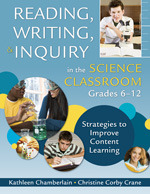Reading, Writing, and Inquiry in the Science Classroom, Grades 6-12
Strategies to Improve Content Learning
- Kathleen Chamberlain - Educational Consultant, Rehoboth Beach, DE
- Christine Corby Crane - Educational Consultant, Athens, PA
"The strategies align with what our preservice and veteran teachers need to teach in today's classrooms. From newspapers, magazines, and research reports to adolescent trade books, the authors offer numerous strategies for supplementing science classes with various reading materials."
—Amy M. Rogers, Instructor of Education
Lycoming College, Williamsport, PA
Combine literacy and inquiry-based instruction to advance student achievement in science!
Integrating reading and writing with inquiry in the science classroom can present a challenge for teachers who may not have a background in reading instruction and who may be concerned about how to strengthen students' literacy skills while effectively teaching science content.
In this timely resource, Kathleen Chamberlain and Christine Corby Crane demonstrate how nurturing strong communication skills can have a significant impact on student performance, and provide research-based strategies for successfully integrating literacy skills with science instruction. Packed with information about reading and writing pedagogy, science standards, adolescent and young adult literature, and lesson design, this book:
- Addresses the relationship between reading and science education, including the use of textbooks and other materials
- Offers methods for teaching writing in the science classroom
- Highlights the role of technology in enhancing students' science knowledge
- Includes sample lesson plans, graphic organizers, and templates suitable for any secondary science classroom, with modifications for students with special needs
The ultimate blend of theory and practice, Reading, Writing, and Inquiry in the Science Classroom, Grades 6–12 helps educators foster the skills to communicate science ideas and experiences and give students an academic advantage.
“The strategies reflect what our preservice and veteran teachers need to teach in today’s classrooms. From newspapers, magazines, and research reports to adolescent trade books, the authors offer numerous strategies for supplementing science classes with various reading materials.”
"Thoroughly addresses lesson planning, vocabulary development, graphic organizers, and meeting the needs of students in special education. This book is especially beneficial for new teachers who want to include reading and writing activities in their daily lesson planning in a science classroom."
